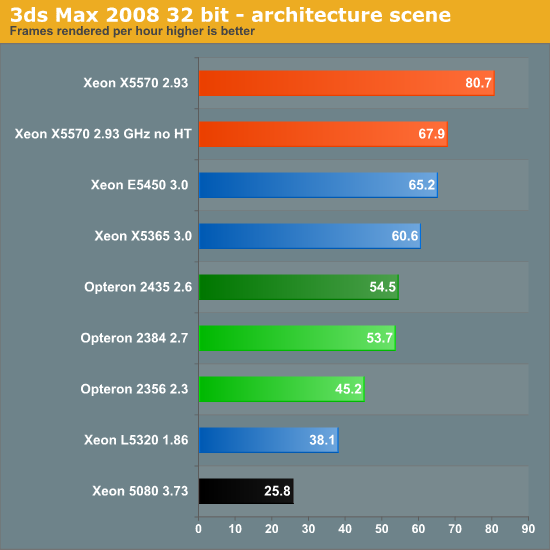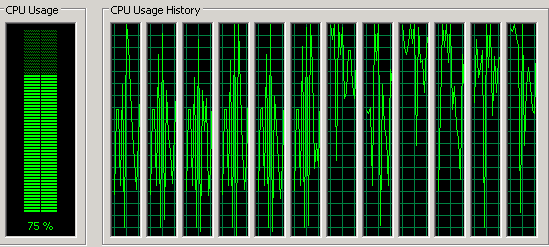Rendering: 3ds Max 2008
Operating System: Windows 2008 Enterprise RTM (64 bit)
Software: 3ds Max 2008
Benchmark software: Build in timer
Typical error margin: 1-2%
We used the "architecture" scene which is included in the SPEC APC 3DS Max test. All tests were done with 3ds max's default scanline renderer, SSE enabled and we rendered at HD 720p (1280x720) resolution. We measured the time it takes to render 10 frames from 20 to 29 with SSE enabled. We recorded the time and then calculated (3600 seconds * 10 frames / time recorded) how many frames a certain CPU configuration could render in one hour. All results are reported as rendered images per hour, higher is thus better.

We used the 32-bit version of 3ds Max 2008 on 64-bit Windows 2008 RTM. The 64-bit version of 3ds Max was a bit slower (especially when we used the Scanline Renderer). All CPU configurations are dual, unless when we indicate otherwise.

We wrote “Some applications do not like core counts that are not a power of 2”. Well, here you have another example. The extra cores of AMD “Istanbul” are close to useless. The Xeon x55xx series outperform the hex-core by almost 50%. The 3DS Max scanline render simply does not know what do with the 12 cores presented. CPU usage went from 50 to 80%:

We are sure that there are probably more efficient render engines out there, but it is simply not a market the AMD six-core should cater to. Nehalem-based Xeons are simply way too powerful for this kind of application. Render engines scale almost perfectly with clockspeed. So if cost is your main concern, consider the Xeon E5520 at 2.26 GHz, the cheapest CPU that still supports HT. We will test this one soon, but we expect it to deliver 67 frames per hour, which is still more than 20% better than any Opteron.










40 Comments
View All Comments
solori - Tuesday, June 2, 2009 - link
I should have said "abundant (cheap) memory."mkruer - Monday, June 1, 2009 - link
I am disappointed that you did not bench X5550 vs 2435. This is the chip that the Opteron 2435 was designed to go up against, not the X5570 which is clocked 300MHz higher and 40% more expensive. Heaven forbid that you try to include chips at the same price point. That being said other sites that did compare based upon price, and not top of the line, show that the Opteron 2435 is indeed comparable to the X5550 at the same price point and speed. Now if AMD can up the speed of the hex core, then it will be a more direct comparison to the X5570. The X5570 is 50% faster but it is also >50% more in cost.mino - Wednesday, June 3, 2009 - link
Right.Actually, I have no qualms with comparing the best with the best, but the commentary is mostly out-of-place.
I guess this was written after 3 days without sleep, but anyway.
After an excelent vAPUS Mark 1 article I would expect better that old-school style:
"1000 $ Pentium 4 3.2 EE is clearly (15%) better than $400 Athlon 3200+ so Athlon is clearly a piece of junk. Well maybe for games not so much but generally it is a piece of junk."
Thank god the numbers tell their own story.
JohanAnandtech - Wednesday, June 3, 2009 - link
It seems that some people like to create the impression that we did not take into account that both CPUs were not at the same pricing.However:
http://it.anandtech.com/IT/showdoc.aspx?i=3571&...">http://it.anandtech.com/IT/showdoc.aspx?i=3571&...
[quote]"However, as the Opteron 2435 competes with 2.66 GHz Xeon and not the Xeon 2.93 GHz, this is the first benchmark where “Istanbul” is competitive."[/quote]
http://it.anandtech.com/IT/showdoc.aspx?i=3571&...">http://it.anandtech.com/IT/showdoc.aspx?i=3571&...
[quote]"The Nehalem-based Xeon moves forward, but does not make a huge jump. Performance of the six-core Opteron was decreased by 2%, which is inside the error margin of this benchmark. It is still an excellent result for the latest Opteron: this results means it will have no trouble competing with the 2.66 Ghz Xeon X5550. "
[/quote]
http://it.anandtech.com/IT/showdoc.aspx?i=3571&...">http://it.anandtech.com/IT/showdoc.aspx?i=3571&...
[quote]"The new Opteron 2435 at 2.6 GHz was a pleasant surprise on vApus Mark I: it keeps up with more expensive Xeons on ESX 3.5 update 4 while consuming less, and offers a competitive performance/watt and performance/price ratio on vSphere 4. The six-core Opteron is about 11 to 30% slower on vSphere 4 than the 2.93 GHz Xeon X5570 but the overall cost of the Istanbul platform is significantly lower (DDR-2 versus DDR-3) and the 2.6 GHz 2435 consumes less power in a virtualized environment "
[/quote]
And I have confidence that the vast majority of my readers are intelligent people who can decrease the benchmarks with 8 to 10% to see what a Xeon x5550 would do
mino - Thursday, June 4, 2009 - link
No, I do not like that, nor like to create such an impression.The article presents the numbers reasonably well for me. It is just that your (justified) love for Nehalem is glowing through and many, many comments were out of place.
I believe this was not intentional but cause by your love for the Nehalem platform which is otherwise great.
All the numbers tell one thing - Istanbull is generally on par with Nehalem clock for clock +- 10% depending on the workload.
About that glowiong love for Nehalem:
>>>MCS eFMS 9.2
"A single 8-thread Xeon X55xx is by far the best choice here."
Why ? There is no 1*2435 number.
Based on the numbers published single 2435 will get about 55-58rps which for all practical needs is identical performance to _flagship_ Nehalem.
>>>3ds Max 2008 32b
"We are sure that there are probably more efficient render engines out there, but it is simply not a market the AMD six-core should cater to. Nehalem-based Xeons are simply way too powerful for this kind of application. Render engines scale almost perfectly with clockspeed. So if cost is your main concern, consider the Xeon E5520 at 2.26 GHz, the cheapest CPU that still supports HT. We will test this one soon, but we expect it to deliver 67 frames per hour, which is still more than 20% better than any Opteron."
OK, so first bash(rightfully) the application fo it rigid resource use pattern, than say that for Nehalem is "way too powerfull for this KIND of application" for Opteron to compete with.
You managed to contradict your own reasoning to promote Nehalem for rendering while the numbers speak about single improperly optimized app.
Which it is pretty certain SW vendor will take care of in due time. These numbers are just a result of no (affordable) 6-core presence on the market up to now.
By these 2 comments you took the article balance from "Instanbul is generally about 5% slower per_clock than Nehalem, in certain apps it is on par or better while in other loses about 15%" - which is what the numbers tell - to "Instanbul is good for VMware, forget about it elsewhere".
Which is about as much bad publicity you could give to the second fastest CPU on the market by_large_margin.
Fact is, at a given price, Nehalem box is ALMOST IDENTICAL performance-wise to Istanbul box. While both crush everything else on the market by 30+ %.
lopri - Monday, June 1, 2009 - link
Page 2, "..The most recent data is however in CPU’s L2-cache" I think you meant CPU #2?JohanAnandtech - Monday, June 1, 2009 - link
Yes, good catch. Fixed the issue.classy - Monday, June 1, 2009 - link
I skipped right to the virtualization portions. It is by far becoming the most dominate criteria for most of the IT world. The 6 core opty looks solid there, so it will come down to price. Now with the quickly developing virtual desktop infrastructures, how well a platform does virtualization makes it just two fold more important. Many folks have already virtualized mission critical apps. I know we're doing exchange in the near future. The days of seperate physical servers and desktops are going the way of the dodo bird. Its becoming all about virtualization.genkk - Tuesday, June 2, 2009 - link
why power consumption not shown here....the bench mark guys in anandtech lost the papers...or they don't want you to seeany way go to techreport.com where istanbul wins
JohanAnandtech - Tuesday, June 2, 2009 - link
More detailed power consumption numbers will be available in the next review.